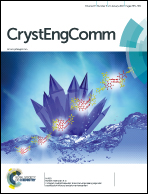Fabrication and formaldehyde sensing performance of Fe-doped In2O3 hollow microspheres via a one-pot method
Abstract
Pure and Fe-doped In2O3 hollow microspheres (HMSs) constructed from numerous nanoparticles have been successfully synthesized via a simple and efficient one-pot method combined with a subsequent thermal treatment. Various techniques were employed to acquire the crystalline and morphological information of the as-obtained samples. Structural characterization indicated that the as-prepared Fe-doped In2O3 HMSs displayed a porous structure with a coarse surface and a diameter of approximately 1 μm. The lattice constants for In2O3 in the Fe-doped product were slightly smaller than those in the pure one, which could be apparently revealed by XRD results. Furthermore, gas sensing performance of the pure In2O3, Fe-doped In2O3 and pure Fe2O3-based gas sensors to the ppm level of formaldehyde (HCHO) vapor was also systematically investigated at a low operating temperature of 260 °C. It has been demonstrated that the Fe-doped In2O3 sensor showed enhanced sensing properties compared with the pure ones with a response of about 12.9 to 100 ppm of HCHO vapor, as well as good selectivity for indoor carcinogenic gases and long-term stability. The enhanced sensing properties could result from the unique hollow structure with a porous shell and the synergic electronic interaction between the guest α-Fe2O3 dopant and the host In2O3 material.



 Please wait while we load your content...
Please wait while we load your content...